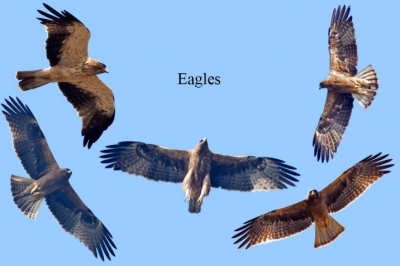
The raptors or birds of prey are differentiated by subtle differences in size, wing shape, feeding habits and hunting grounds, making each species unique. Some of the more common species of raptors are as follows…
Eagles- They are the largest raptors with exceptional eye-sight 8 times more powerful than humans. They have large, thick beaks and long, wide wings. They build their nests called eyries in tall trees or on high cliffs. They are generally considered to be the apex predator among all birds.
Hawks- They generally have short, roundish wings and long tails and are divided into forest hawks (called accipiters) and grassland hawks (called buteos).
Harriers- They are medium-sized raptors that fly low while hunting and have a unique facial disk that helps them to hear their prey better while hunting. They mostly hunt small mammals and rodents.
Kites- They are small to medium-sized raptors with tapered, slender wings and deeply forked tails. They have short legs and are graceful in flight. They are found soaring above in the air currents for long periods of time. They generally eat small vertebrates but will also eat insects and carrion.
Osprey- They are fish-hunters and are generally found on every continent in the world except Antarctica. They build big, stick nests.
Owls- They are night-hunting raptors that range from small to medium to large sizes. Their unique arrangement of wing feathers reduces turbulence, which allows them to fly silently. This helps them to pounce on unwary prey in the night making them excellent night-predators. They have exceptional hearing and night vision.
Vultures- They are large, scavenging raptors with bald, featherless heads. They are also called condors or buzzards and can soar in the air for hours searching for carrion. They are also one of the few raptors that are social and gather together to feed.
Falcons- They are medium-sized raptors with pointed wings built for speed and agility. Many of them are especially fast fliers, with the peregrine falcon reaching dive speeds of over 320 kilometres per hour!
Picture Credit : Google




